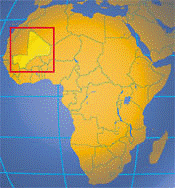International Sorghum and Millet Collaborative Research Support Program (INTSORMIL CRSP)
Date of this Version
12-2009
Document Type
Article
Citation
INTSORMIL Mali: A Day in the Village, December 2009
Abstract
Approximately 80 percent of Malians engage in agriculture as a source of income, producing cotton, millet, sorghum and rice. Nearly twothirds of the country lives below the poverty line, and 74 percent earn less than $2 a day. The most productive land is located near the Niger river. Droughts and locust swarms regularly challenge agricultural and pastoral ways of life.
The INTSORMIL Program collaborates with the Malian National Program, IER in the promotion of sorghum and pearl millet production and marketing. INTSORMIL host country coordinator Mamourou Diourte (white cap) is shown at a field day promoting the production of an improved sorghum variety Seguifa. The banner says “Adopt the sorghum variety Seguifa in all production areas to increase production. Assure food security and participate in the economic growth of Mali.“
Dr. Bahiru Duguma, INTSORMIL Agreement Officer’s Technical Representative (AOTR), USAID Washington DC observing the small panicles of local millet and sorghum varieties in a field that has been harvested near Mopti, Mali. Note the large weeds. Farmers in the Kayes Region in Northwest Mali near Mauritania have almost stopped the planting of pearl millet because of the severe damage caused by blister beetles feeding on the panicles.

